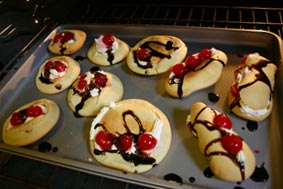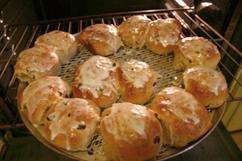
Doughnut
This is a slight variation of the recipe at http://the99centchef.blogspot.com/2009/05/krispy-kreme-doughnut-recipe-video.html
This recipe will make a baker’s dozen ring doughnuts or approximately 8 rectangular cream cake doughnuts.
- 1/2 package yeast (approx. 1 Tablespoon)
- 1/4 cup lukewarm water (100 degrees)
- 3/4 cup of warm milk (100 degrees)
- 2 tablespoons of sugar
- 1 egg
- 2 Tablespoons butter or shortening (softened to room temperature )
- 1/2 teaspoon salt
- 2 cups flour (The first time I made this, I actually had to add an additional 1/3 c. and then another 1/4 c. when I made this – but it’s possible that I got one of the earlier measurements wrong.)
In a cup, dissolve yeast and sugar in the warm water and allow yeast to froth.
Mix warm milk, egg, salt, and butter and after well combined, slowly add the first cup of flour. Add the yeast/sugar/water mixture and then the rest of the flour.
Mix well for a few minutes.
In the end, the dough should be soft and slightly sticky to the touch, but should not be ‘wet’.
Cover dough and allow to rise for at least a hour, or overnight for breakfast doughnuts.
Lightly sprinkle flour over the dough, and punch it down (the flour will stop the dough from sticking to your fists!).
Empty the dough onto a lightly floured surface, roll out doughnut dough with a rolling pin about 1/2 an inch thick.
Add only enough flour to stop the dough from sticking – you must retain the moisture in the dough, as the moisture is crucial in the cooking process.
For ring doughnuts, cut with a cutter (suggested 3″ diameter), then a smaller cutter for the centers. You can set aside the doughnut holes with the doughnuts or re-roll them for another doughnut or two.
For filled doughnuts, just cut with the larger cutter.
For rectangular doughnuts use a pizza cutter or sharp knife to cut approx. 2″ x 4″or5″ rectangles.
Let cut doughnuts set for 30-40 minutes to rise one last time before frying at 365°F.
Drain on a wire rack.
For filled doughnuts, I use a baster to insert the filling.
For cream-cake style doughnuts, make an diagonal cut shortly after removing from the oil (it will cut easier before it gets soft). After cooled, toss in granulated sugar and then fill with cream (and jam if you like).
Baked Oatmeal (my mother’s recipe, downsized from a Teen Missions recipe)
3/4 c. oil
4 1/2 c. quick oats or small rolled oats
1 1/2 c. milk
3/4 c. sugar
3 tsp baking powder
3 eggs
1 1/2 tsp salt
2 tsp cinnamon
Bake 30 min. @ 350F
Serve with warm milk.
Choux Pastry

- ¼ cup butter
- 1 cup water
- ¼ teaspoon salt
- 1 cup all-purpose flour
- 4 eggs
Hot Cross Buns
contributed by Sharon

makes 24
- 1 cup milk
- 2 Tbsp yeast
- 1/2 cup sugar
- 2 tsp. salt
- 1/3 cup butter, melted and cooled
- 1 1/2 tsp. cinnamon
- 1/2 tsp. nutmeg
- 4 eggs
- 5 cup flour
- 1 1/3 cup currants or raisins
- 1 egg white
Glaze (you can use this one or your favorite)
- 1 1/3 cup confectioner’s sugar
- 1 1/2 tsp. finely chopped lemon zest
- 1/2 tsp. lemon extract
- 1-2 Tbsp milk
This may be difficult for younger children to do themselves, but they’ll enjoy helping to mix and measure the ingredients, helping to knead the dough, forming the dough into balls and adding the glaze.
In a small saucepan, heat milk to very warm, but not hot (110°F if using a candy thermometer). Pour warm milk in a bowl and sprinkle yeast over. Mix to dissolve and let sit for 5 minutes.
Stirring constantly, add sugar, salt, butter, cinnamon, nutmeg and eggs. Gradually mix in flour, dough will be wet and sticky. Continue kneading until smooth, about 5 minutes. Cover bowl with plastic wrap and let the dough “rest” for 30-45 minutes.
Knead again until smooth and elastic, for about 3 more minutes. Add currants or raisins and knead until well mixed. At this point, dough will still be fairly wet and sticky. Shape dough in a ball, place in a buttered dish, cover with plastic wrap and let rise overnight in the refrigerator. Excess moisture will be absorbed by the morning.
Let dough sit at room temperature for about a half-hour. Line a large baking pan (or pans) with parchment paper (you could also lightly grease a baking pan, but parchment works better). Divide dough into 24 equal pieces (in half, half again, etc., etc.). Shape each portion into a ball and place on baking sheet, about 1/2 inch apart. Cover with a clean kitchen towel and let rise in a warm, draft-free place until doubled in size, about 1 1/2 hours.
In the meantime, pre-heat oven to 400° F.
When buns have risen, take a sharp or serrated knife and carefully slash buns with a cross. Brush them with egg white and place in oven. Bake for 10 minutes, then reduce heat to 350° F, then bake until golden brown, about 15 minutes more. Transfer to a wire rack. Whisk together glaze ingredients, and spoon over buns in a cross pattern. Serve warm, if possible.
Cinnamon and Sticky Buns
(from Peter Reinhart’s The Bread Baker’s Apprentice)
Days to Make: One (1)
Active/Resting/Baking Time: 15 minutes to mix, 3 1/2 hours fermentation/shaping/proofing, 20 – 40 minutes to bake
Recipe Quantity: Eight(1) – twelve (12) large rolls or twelve (12) – sixteen (16) small rolls
Making the Dough
Ingredients:
- 6 1/2 tablespoons (3.25 ounces) granulated sugar
- 1 teaspoon salt
- 5 1/2 tablespoons (2.75 ounces) shortening or unsalted butter or margarine
- 1 large egg, slightly beaten
- 1 teaspoon lemon extract OR 1 teaspoon grated zest of 1 lemon
- 3 1/2 cups (16 ounces) unbleached bread or all-purpose flour
- 2 teaspoons instant yeast*
- 1 1/8 to 1 1/4 cups whole milk or buttermilk, at room temperature OR 3 tablespoons powdered milk (DMS) and 1 cup water
- 1/2 cup cinnamon sugar (6 1/2 tablespoons granulated sugar plus 1 1/2 teaspoons ground cinnamon, or any other spices you want to use, cardamom, ginger, allspice, etc.)
- White fondant glaze for cinnamon buns or caramel glaze for sticky buns (at the end of the recipe.)
- Walnuts, pecans, or other nuts (for sticky buns.)
- Raisins or other dried fruit, such as dried cranberries or dried cherries (for sticky buns, optional.)
*Instant yeast contains about 25% more living cells per spoonful than active dry yeast, regardless of the brand. Instant yeast is also called rapid-rise or fast-rising.
Step 1 – Making the Dough: Cream together the sugar, salt, and shortening or butter on medium-high speed in an electric mixer with a paddle attachment (or use a large metal spoon and mixing bowl and do it by hand).
Note: if you are using powdered milk, cream the milk with the sugar, and add the water with the flour and yeast.
Whip in the egg and lemon extract/zest until smooth. Then add the flour, yeast, and milk. Mix on low speed (or stir by hand) until the dough forms a ball. Switch to the dough hook and increase the speed to medium, mixing for approximately 10 minutes (or knead by hand for 12 to 15 minutes), or until the dough is silky and supple, tacky but not sticky. You may have to add a little flour or water while mixing to achieve this texture. Lightly oil a large bowl and transfer the dough to the bowl, rolling it around to coat it with oil. Cover the bowl with plastic wrap.
Step 2 – Fermentation: Ferment at room temperature for approximately 2 hours, or until the dough doubles in size.
Step 3 – Form the Buns: Mist the counter with spray oil and transfer the dough to the counter.
To shape the buns: (A) Roll out the dough with a rolling pin, lightly dusting the top with flour to keep it from sticking to the pin. Roll it into a rectangle about 2/3 inch thick and 14 inches wide by 12 inches long for larger buns, or 18 inches wide by 9 inches long for smaller buns. Don´t roll out the dough too thin, or the finished buns will be tough and chewy rather than soft and plump. (B)Sprinkle the cinnamon sugar over the surface of the dough and (C) roll the dough up into a cigar-shaped log, creating a cinnamon-sugar spiral as you roll. With the seam side down, cut the dough into 8 to 12 pieces each about 1 3/4 inches thick for larger buns, or 12 to 16 pieces each 1 1/4 inch thick for smaller buns.)
Step 4 – Prepare the Buns for Proofing:
- For cinnamon buns: line 1 or more sheet pans with baking parchment. Place the buns approximately 1/2 inch apart so that they aren´t touching but are close to one another.
- For sticky buns: coat the bottom of 1 or more baking dishes or baking pans with sides at least 1 1/2 inches high with a 1/4 inch layer of the caramel glaze. Sprinkle on the nuts and raisins (if you are using raisins or dried fruit.) You do not need a lot of nuts and raisins, only a sprinkling. Lay the pieces of dough on top of the caramel glaze, spacing them about 1/2 inch apart. Mist the dough with spray oil and cover loosely with plastic wrap or a food-grade plastic bag.
Step 5 – Proof the Buns: Proof at room temperature for 75 to 90 minutes, or until the pieces have grown into one another and have nearly doubled in size. You may also retard the shaped buns in the refrigerator for up to 2 days, pulling the pans out of the refrigerator 3 to 4 hours before baking to allow the dough to proof.
Step 6 – Bake the Buns:
- Preheat the oven to 350°F (175°C) with the oven rack in the middle shelf for cinnamon buns but on the lowest shelf for sticky buns.
- Bake the cinnamon buns for 20 to 30 minutes or the sticky buns 30 to 40 minutes, or until golden brown. If you are baking sticky buns, remember that they are really upside down (regular cinnamon buns are baked right side up), so the heat has to penetrate through the pan and into the glaze to caramelize it. The tops will become the bottoms, so they may appear dark and done, but the real key is whether the underside is fully baked. It takes practice to know just when to pull the buns out of the oven.
Step 8 – Cool the buns:
- For cinnamon buns, cool the buns in the pan for about 10 minutes and then streak white fondant glaze across the tops, while the buns are warm but not too hot. Remove the buns from the pans and place them on a cooling rack. Wait for at least 20 minutes before serving.
- For the sticky buns, cool the buns in the pan for 5 to 10 minutes and then remove them by flipping them over into another pan. Carefully scoop any run-off glaze back over the buns with a spatula. Wait at least 20 minutes before serving.
Toppings for the Buns:
White fondant glaze for cinnamon buns
Cinnamon buns are usually topped with a thick white glaze called fondant. There are many ways to make fondant glaze, but here is a delicious and simple version, enlivened by the addition of citrus flavor, either lemon or orange. You can also substitute vanilla extract or rum extract, or simply make the glaze without any flavorings.
Sift 4 cups of powdered sugar into a bowl. Add 1 teaspoon of lemon or orange extract and 6 tablespoons to 1/2 cup of warm milk, briskly whisking until all the sugar is dissolved. Add the milk slowly and only as much as is needed to make a thick, smooth paste.
When the buns have cooled but are still warm, streak the glaze over them by dipping the tines of a fork or a whisk into the glaze and waving the fork or whisk over the tops. Or, form the streaks by dipping your fingers in the glaze and letting it drip off as you wave them over the tops of the buns. (Remember to wear latex gloves.)
Caramel glaze for sticky buns
Caramel glaze is essentially some combination of sugar and fat, cooked until it caramelizes. The trick is catching it just when the sugar melts and lightly caramelizes to a golden amber. Then it will cool to a soft, creamy caramel. If you wait too long and the glaze turns dark brown, it will cool to a hard, crack-your-teeth consistency. Most sticky bun glazes contain other ingredients to influence flavor and texture, such as corn syrup to keep the sugar from crystallizing and flavor extracts or oils, such as vanilla or lemon. This version makes the best sticky bun glaze of any I´ve tried. It was developed by my wife, Susan, for Brother Juniper´s Cafe in Forestville, California.
NOTE: you can substitute the corn syrup for any neutral flavor syrup, like cane syrup or gold syrup.
1. In the bowl of an electric mixer, combine 1/2 cup granulated sugar, 1/2 cup firmly packed brown sugar, 1/2 teaspoon salt, and 1/2 pound unsalted butter, at room temperature.
2. Cream together for 2 minutes on high speed with the paddle attachment. Add 1/2 cup corn syrup and 1 teaspoon lemon, orange or vanilla extract. Continue to cream for about 5 minutes, or until light and fluffy.
3. Use as much of this as you need to cover the bottom of the pan with a 1/4-inch layer. Refrigerate and save any excess for future use; it will keep for months in a sealed container.
Quick Cinnamon Rolls
Cook Time: 25 minutes
Ingredients:
- 1/4 cup plus 1 1/2 teaspoons shortening
- 3 cups self-rising flour (3 cups flour with 3 small pinches of salt, and 3 3/4 teaspoons of baking powder)
- 1 cup milk
Filling
- 1/2 cup butter or margarine, softened
- 1/2 cup sugar
- 1/2 cup firmly packed brown sugar
- 1 tablespoon ground cinnamon
- 3/4 cup chopped pecans (optional)
- 1/2 cup raisins (optional)
Vanilla Glaze:
- 1 1/4 cups sifted powdered sugar
- 3 tablespoons milk
- 1/4 teaspoon vanilla
Preparation:
Cut shortening into flour with pastry blender until mixture resembles coarse meal. Add 1 cup milk, stirring until dry ingredients are moistened. Turn dough out onto a floured surface; knead lightly.
Roll dough into a 20×14-inch rectangle; spread the softened butter on dough, leaving a border of about 1/2-inch. Combine sugar and cinnamon; mix well, and sprinkle over butter. Top with pecans and raisins, if using. Beginning at long side, roll up jelly roll fashion; press edges and ends together securely. Cut into 1 inch slices; place cut side down in a buttered 13x9x2-inch baking pan. Bake at 375° for 20 to 25 minutes.
Combine powdered sugar and 3 tablespoon milk and vanilla; drizzle over warm rolls. Makes 20 cinnamon rolls.

